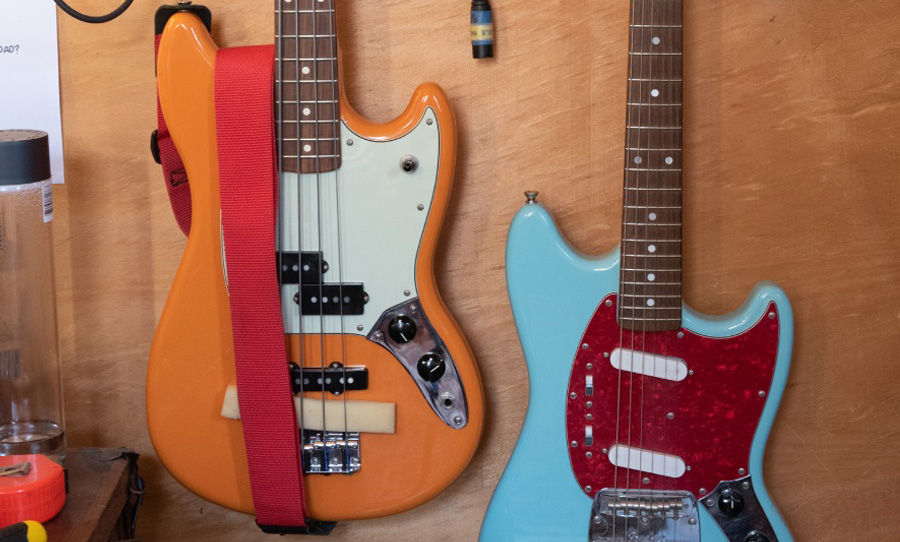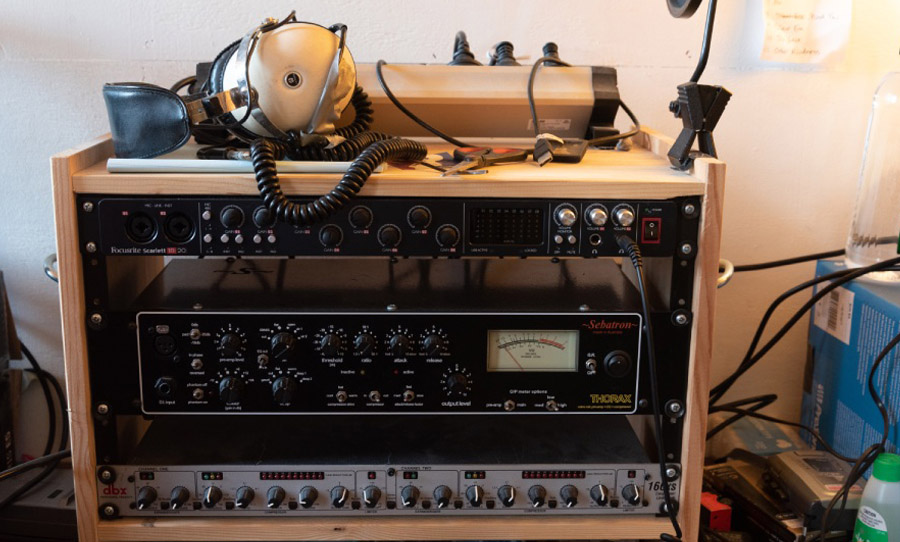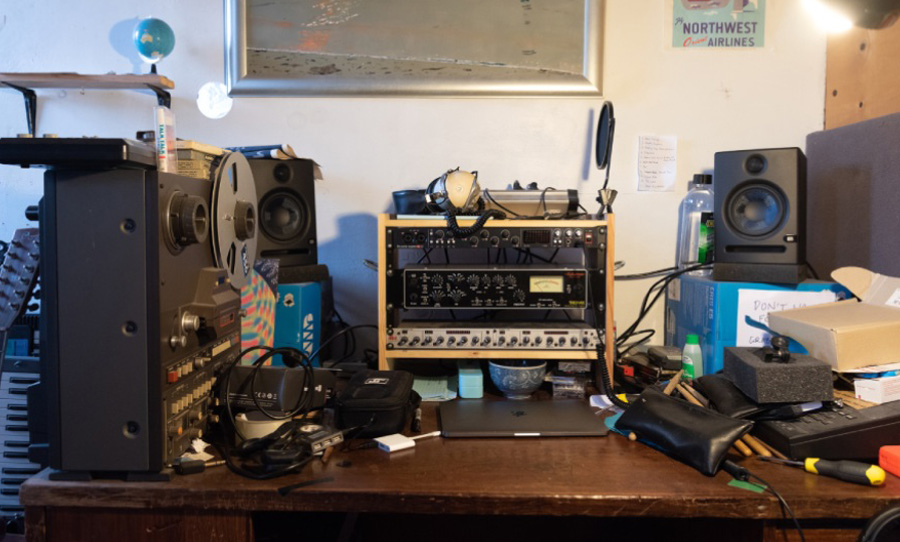Nick Sowersby has been busy in his home studio putting together his new album Goodness Gracious. We spoke to the man himself about the tools and processes that steer the Sunbeam Sound Machine.
Sunbeam Sound Machine is the dream pop project of Melbourne-based multi-instrumentalist and producer Nick Sowersby. First receiving attention with 2013’s One/Sunbeam Sound Machine double-EP, Nick released 2014’s highly acclaimed Wonderer and charmed fans with a tour of Australia and the US
Ever since Sunbeam Sound Machine’s debut, fans have been eagerly awaiting another dose of dreamy ethereal goodness. Lucky for them Nick’s follow up, Goodness Gracious was released last month through Dot Dash/Remote Control Records, with Bandcamp vinyl selling out weeks ahead and a debut at number #10 on the NACC (North American College and Community Chart).
There’s no question that Nick is on a steady trajectory here, like a powerful solar flare radiating through space. Where Wonderer was more of an experimental headphone affair, Goodness Gracious is a more instrumentally solid and expansive Sunbeam Sound Machine journey, featuring extensive looping work and guitars layered thicker than a glass onion. The self written, self-produced album was recorded and mixed by Sowersby in his own studio, before being mastered by John Lee (Laura Jean, Lost Animal, Totally Mild) at Phaedra Studios.
We caught up with Sowersby for a chat to see how one person puts together such an immersive and enigmatic experience.

ENMORE AUDIO: Tell us a bit about how it came together.
NICK SOWERSBY: I started working on the album initially towards the end of 2015, after we’d been playing a bunch of live shows in support of the first Sunbeam Sound Machine album Wonderer. There were a few factors that made me really rush into making the album and I ended up scrapping most of what I’d recorded around mid-2016 and starting again. This time I set no deadlines and just wrote and recorded until something started to naturally take shape.
ENMORE AUDIO: When you started recording, was there something you set out to achieve in terms of sound and production?
NICK SOWERSBY: The previous album was very much a headphone listening experience. I wanted that one to feel like it was all happening inside someone’s head and it was really heavily layered and processed. This time I wanted to make something more intimate and natural sounding, something that you might play through speakers.
I wanted the songs to come first and the production to serve them, whereas on the last album it was more of a 50/50 split. That was what I had in mind, but I’m ok with the songs and production mutating into something else along the way. I’m not that excited by having an exact goal in mind and trying to achieve it, I like being surprised by where a song ends up.
ENMORE AUDIO: It’s awesome that it was recorded all from home, can you give us a quick rundown of your studio?
NICK SOWERSBY: I only have one somewhat fancy piece of gear, which is a Sebatron Thorax pre-amp, so pretty much everything runs through that, then into a Scarlett 18i20 interface, then into Logic. I have a Yamaha MT4X cassette recorder that I sometimes use but generally everything’s pretty digital so the Sebatron helps warm it up and take that sheen off it, which is especially good for DI-ing guitars.
All the guitar effects come from my pedal board. I like to give myself that limit so I don’t waste time going through millions of effects on Logic. There’s a bunch of other bits and pieces laying around that get used occasionally. I picked up a reel-to-reel a while ago that I’m hoping learn how to use so maybe that’ll get a run soon.
ENMORE AUDIO: Is there any gear that you feel really shaped the album?
NICK SOWERSBY: Well obviously everything runs through the Sebatron so that has a fair effect. The ElectroVoice 635a was a big one on this album. I took a sound production course a couple of years ago and one of my teachers said “you can hammer in a nail with one of these and record straight away. They’re indestructible. If you see one, get one.” He also said they were cheap so I immediately looked them up on eBay and some guy at a college in Iowa had found 48 of them in a cupboard.
I grabbed a couple and found it to be a perfect mic for my vocals, just faithful enough while still adding character. It also served really well as a kick drum mic on the album. Another one was playing my Mustang guitar on this record, which gave me a sharper guitar tone and made me feel less need to layer everything so much.

ENMORE AUDIO: Was there anything you were listening to at the time that really influenced the sound of the album?
NICK SOWERSBY: The Velvet Underground’s self-titled album (not the Nico one, but that’s also great) and Bruce Springsteen’s Nebraska got me thinking about recording things more intimately, even though the album ended up sounding a long way away from that. Another one that wouldn’t sound like a big influence but was is Talk Talk’s Spirit Of Eden.
That album’s been huge for me the last few years. Often I’m inspired by particular songs more than albums and the production was pretty heavily influenced by a few obscure 70’s tracks, like Santa Cruz Mountains by Eddie Callahan and One Million Miles From The Ground by Dexter Wansel, among others.
ENMORE AUDIO: I particularly love the atmosphere that you create in your songs. How does layering come into your composition?
NICK SOWERSBY: I’m big on having an atmosphere around the edges of a song. Usually, I’ll loop some guitars or keys and hard pan them so they just colour things from the sides. I’m also really intent on the way different instruments interact and the textures that creates, that can have a big impact on the atmosphere and emotional pull of a song which is one of the most important things to me. With this album I definitely tried to make sure the core of the song was really there before I started colouring it in with all that stuff though.
ENMORE AUDIO: The soundscape on Tru Love is super mesmerising, sounds heavy on the reverse delay. Can you pick that one apart for us?
NICK SOWERSBY: That’s actually the two guitar parts from the previous song, Silent Era, reversed. I came across it by accident and it punched me in the guts, which is always a good sign.
ENMORE AUDIO: It sounds like looping is a big part of some of your tracks. How does it fit into your creative process?
NICK SOWERSBY: That song Tru love was made using the Line 6 DL4, which is kind of the quintessential loop pedal, and a huge part of my creative process. A lot of the songs are based on loops which come from that, but it’s also a big part of writing the songs that aren’t.
As soon as I come up with a new guitar part, I’ll loop it, come up with a second guitar part, loop that, then come up with a bass line. That gives me a one or two bar phrase that essentially acts as the demo for each song. It also has the half-speed and reverse functions, which I always try out to see if it’ll take a song somewhere interesting like it did with Tru Love and a couple of others on the album.
ENMORE AUDIO: Can you run us through what’s on your board at the moment?
From guitar to amp: Korg Pitchblack, Digitech Whammy, Line 6 DL4, EHX Small Stone Nano, Digitech DL-8, TC Electronic Shaker, EHX Holy Grail, DOD Overdrive 250.
ENMORE AUDIO: How do you approach your signal chain/routing? Do you have any particular ethos when it comes to using guitar pedals?
NICK SOWERSBY: It’s set up more for the writing process than for any particular tone. The pitch-shifter comes before the looper so I can pitch it down and loop bass lines, and everything else comes after the looper so I can essentially mix the loops on my pedalboard and see what happens when I add delay and other effects.
ENMORE AUDIO: If you had to cull your board down to two pedals, what would they be and why?
NICK SOWERSBY: I’d find it hard to part with that TC Electronic vibrato, that might be my favourite pedal, but I’d have to go with the Whammy and DL4. They’re so useful together for writing songs but they’re also a big part of my overall guitar sound. I use the Whammy to add intervals and find interesting chords and I use that modulating, fast delay from the DL4 a lot which gives everything a shimmering quality.

ENMORE AUDIO: What was the first pedal you bought?
NICK SOWERSBY: I got a pack of 4 pedals off Ebay when I was maybe 15 or 16. It was a chorus, distortion, flanger and something else. They were super cheap and I soon found out why when most of them broke really easily. I’ve always been into bargains with my music gear, for better or worse. I liked the chorus though, I’ve still got it somewhere.
ENMORE AUDIO: What’s the cheapest stompbox that you’ve gotten the most value out of?
NICK SOWERSBY: After that little outing I got really into Behringer pedals. They were 50 bucks and lasted slightly longer… I really loved the sound of their reverb pedal and you could turn the feedback on their delay pedals all the way up without it getting louder, which was my first foray into looping.
ENMORE AUDIO: Is there anything you’re really hanging out to buy at the moment?
NICK SOWERSBY: Dan, who plays guitar in the Sunbeam live band, has an EarthQuaker Devices Avalanche Run and a Cooper FX Generation Loss that I get really jealous of at practise. He uses them for delay, lo-fi looping and these filter sweeps that sound really beautiful. Apart from that, I’m pretty satisfied on the pedal front, which is weird. Studio-wise I’ve got a couple of nicer mics lately and I’m teetering dangerously on the edge of that rabbit-hole.
ENMORE AUDIO: Do you have any pedal heroes or other artist who you feel really nail a sound through their rig?
NICK SOWERSBY: I think I got into the DL4 through being really into TV On The Radio. Dave Sitek uses one or two in his guitar setup and Tunde Adebimpe uses one for his vocals. Alex Scally and Daniel Rossen are two of my guitar heroes who get really beautiful sounds from their setups and I love the wild sounds Annie Clark gets from her pedals and playing too. I think I’ve always enjoyed trying to emulate their sounds with my own setup and falling short, that’s where you tend to find your own sound.



